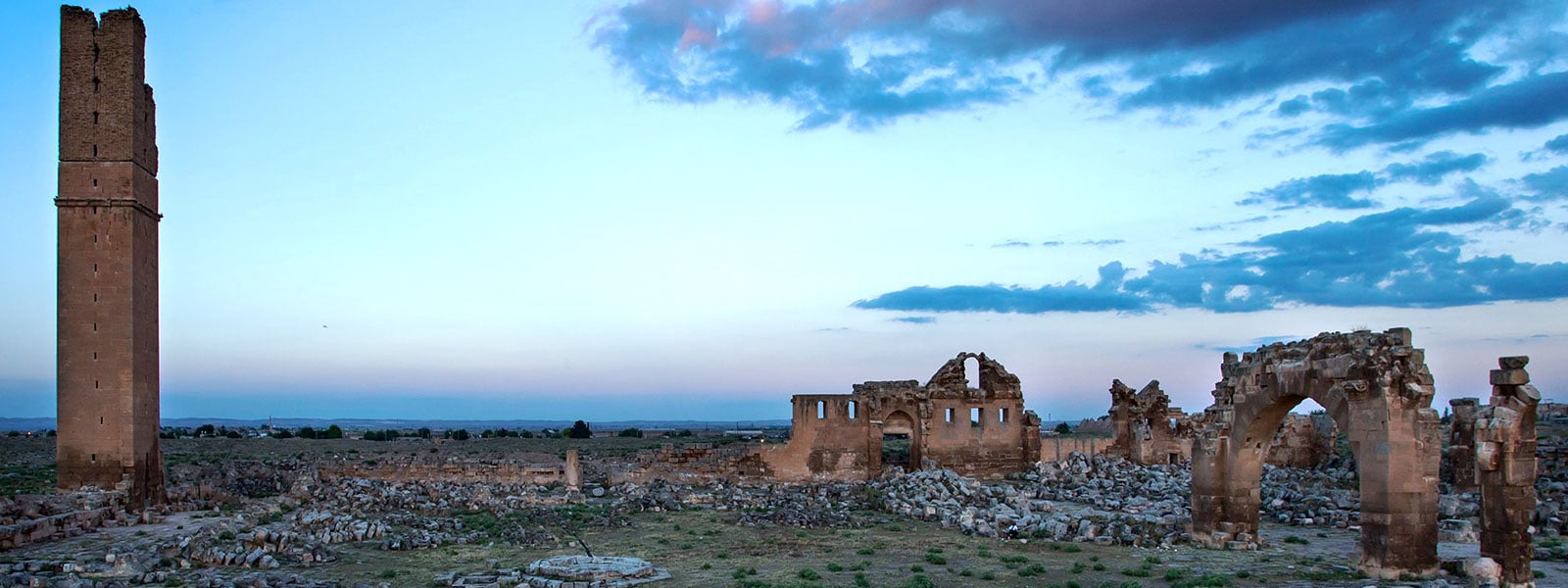
HARRAN
Harran in Turkey, inhabited since the early centuries, is an important site for Judaism, Christianity, and Islam being considered to be home of Abraham when he heard God’s call, Abraham "the father of many nations" and "the friend of God," is held by the Jews, the Christians, and the Muslims to be their patriarch. Historians put his date - assuming that he was a historical person - anywhere between 3,000 and 900 BC. The most commonly accepted date is sometime between 2,000 and ’1,500 BC. A 13 century AD reference by the Arabic scholar Ali al-Harawi says that Abraham’s sanctuary at the city was called the Sanctuary of the Rock and that he used to sit there when he tended his sheep. Al-Harawi also mentions that there was a small mosque on the site.
The Jewish and the Christian traditions hold that his father Terah led his clan in its migration from Ur of the Chaldees to Harran (Gen. 11:31.). It is referred to as Aramnaharaim, meaning "the land of the Arameans of Two Rivers." The Aramean clan traced its ancestry to Noah’s grandson Aram.
The distance between Ur of the Chaldees in southern Mesopotamia (once a thriving city with a long history) and Harran in today’s Southeastern Turkey presents a problem to some scholars. The location of the city is less questioned than that of Ur because it is identified not only in this city itself but also because it is referred to in tablets found in Nuzi in northeastern Iraq. Ur is not as certain. According to the prevailing theory, Terah and his clan would have had to make the thousand-kilometer trek following the Euphrates northwest, the Balikh north and then the Cullab (a tributary of the Balikh) to get to Haran.
It is a long, but not an impossible journey for nomads. However, there is a small minority opinion that presents evidence that Terah may not have traveled so far. These scholars suggest that Chaldea extended from the delta of the Tigris and the Euphrates on the Persian Gulf into northeastern Anatolia. With that, they add the early tradition that Terah’s Ur was Urfa (or Edessa). The evidence is partly religious, partly linguistic: Religiously, Ur in Southern Mesopotamia, Harran in Southeastern Turkey and its neighbor Sanliurfa shared the distinction of being important centers of the worship of the moon god Sin.



In linguistics, the language of the early Chaldeans was Semitic and possibly Aramaic. "Laban," the name of Abraham’s nephew, in Semitic meant "wl-iite" and referred to the moon god. In themselves, these points neither prove nor disprove the location of Ur of the Chaldees, but they are some of the many threads that cross and re-cross here. By the 9 century BC, Aramaic was the lingua franca of the Middle East. Parts of the Old Testament were written in Aramaic; one of its dialects is probably the language that Jesus spoke.
Jews and Christians believe that he was called on to sacrifice his son Isaac; Muslims believe that Ismael (the son of Rebecca’s slave Hagar whom Abraham sent out into the desert) was the son whom Abraham would have sacrificed and with whom he founded his holy house. The three religions share a number of prophets and apostles besides him.
The Koran reads, "We believe in God. We believe in what has been revealed to us through Abraham, Ismael, Isaac, Jacob, and their tribes, to Moses and to Jesus, in what has been revealed to the prophets by God. We do not make a difference between any of them, and we submit ourselves to God." This Islamic tolerance is part of the background of the coexistence of peoples of different faiths over the years.
On his death, Abraham’s father Terah was buried in this city. After he heard God’s call to found a great nation and to move to the land of Canaan, some of the members of his extended family stayed in the city.
When it was time for his son Isaac to take a wife, Abraham was concerned that Isaac should not choose one of the Canaanite women. (The Canaanite religion was loathed because it was associated with the Weather-god Baal and the eroticism of a fertility cult.) Therefore he sent his servant back to the city to get a woman from his own tribe. This girl turned out to be Rebecca, one of his nieces. A similar story of recourse to the family in the city occurred when Isaac’s son Jacob had to flee from Esau’s wrath because Jacob had cheated him out of his birthright. Back in Harran, Jacob started looking for his cousin Laban. By chance Laban’s daughter, Rachel came up to water the sheep. Smitten, Jacob rolled the stone off the well for her and took his thanks in the form of a kiss. While Laban agreed to the marriage, he not only made Jacob work seven years before he could marry her older sister Leah he also made Jacob work a second seven for Rachel who had been his first choice. It was a high price, but then Jacob probably was not in any hurry to go home and face Esau (Gen.27:41-29:30).
The destination apart from its ancient university, beehive houses or Dara Ruins (closely on the way to Midyat) offers many other important sites to visit. We do operate Southeastern Turkey Tours privately as well to let you enjoy a better path.
